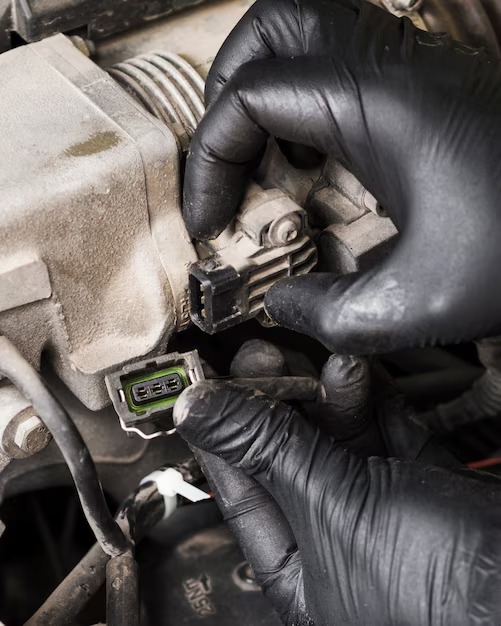Understanding Anti-Lock Brake System How ABS Functions in Vehicles

Understanding Anti-Lock Brake System How ABS Functions in Vehicles
When it comes to modern vehicles, safety features play a pivotal role in enhancing the driving experience. Among these innovations lies a particularly significant system designed to aid drivers during challenging conditions. By prioritizing control and maneuverability, this technology serves as a crucial ally on the road.
One of the key functions of this advanced system is to prevent wheel lock-up during sudden braking scenarios. By maintaining optimal traction, it helps to preserve steering capabilities, allowing drivers to navigate through unexpected obstacles. This remarkable feature not only improves safety but also instills confidence in drivers as they traverse diverse terrains.
Delving into the intricacies of this essential mechanism reveals a blend of engineering prowess and intelligent design. Its seamless integration into vehicle dynamics reflects a commitment to safety, ensuring that both drivers and passengers are protected in a variety of situations. Through an exploration of its components and functionalities, one can appreciate the role this system plays in enhancing road safety and performance.
What is ABS and Its Purpose
Antilock braking systems are critical components in modern vehicles, designed to enhance safety and control during emergency situations. They help prevent wheels from locking up during hard braking, ensuring that the driver maintains steering ability while reducing stopping distances on slippery surfaces.
The primary function of these systems is to monitor wheel speed and adjust brake pressure accordingly. By preventing wheel lock, they allow for more effective maneuvering, especially in challenging conditions such as rain, snow, or ice. This added control significantly reduces the risk of skidding and enhances overall stability.
In essence, this advanced technology serves as a safeguard, contributing to safer driving experiences. By improving traction and allowing for better vehicle handling, it plays a pivotal role in accident prevention and driver confidence.
How ABS Improves Vehicle Safety
The implementation of advanced braking systems has significantly enhanced the safety of modern vehicles. These systems are designed to prevent wheel lockup during emergency situations, allowing drivers to maintain steering control while braking. This technology plays a crucial role in minimizing the risk of accidents, especially in adverse conditions.
One of the primary benefits of this innovation is the reduction of stopping distances on slippery surfaces. By modulating brake pressure, these systems enable vehicles to slow down effectively while retaining maneuverability. Moreover, improved vehicle stability leads to increased driver confidence, which is particularly vital during critical driving scenarios.
| Feature | Benefit |
|---|---|
| Prevents Wheel Lockup | Allows for better steering control |
| Enhanced Stopping Power | Reduces stopping distances in slippery conditions |
| Improved Stability | Increases driver confidence in emergencies |
| Adaptability | Works effectively in various weather conditions |
Such features collectively contribute to the overall safety profile of vehicles, making them a vital component for modern transportation. As technology continues to evolve, these systems will likely become even more sophisticated, further enhancing road safety for all users.
Components of an ABS System
The braking control mechanism relies on several critical elements that work in conjunction to enhance safety and performance during stopping maneuvers. Each component plays an essential role in optimizing the overall functionality, contributing to a smoother and more controlled deceleration process.
Sensors
Sensors are pivotal in monitoring wheel speed, providing real-time data to the control unit. These devices detect any variations from normal rotation rates, allowing the system to respond timely to potential skidding or loss of traction.
Control Module
The control module acts as the brain of the mechanism, processing information from the sensors and making rapid adjustments to braking force. This unit activates and deactivates individual brake calipers, ensuring maximum grip while preventing wheel lock-up.
Functionality of Anti-lock Braking
The technology employed in modern vehicles to enhance braking efficiency plays a crucial role in maintaining control during sudden stops. This system is designed to prevent wheel lock-up, ensuring optimal tire traction on various surfaces, which ultimately contributes to safer driving experiences.
Mechanism of Action
When the driver presses the brake pedal, the system continuously monitors wheel speed through various sensors. If it detects that a wheel is about to lose traction, it reduces brake pressure momentarily, allowing the wheel to regain grip. This rapid modulation enables the driver to steer effectively while braking, significantly decreasing the possibility of skidding.
Benefits of Implementation
The incorporation of this advanced braking mechanism offers several advantages. It enhances vehicle stability during emergency situations, reduces stopping distances on slippery roads, and provides greater driver confidence in challenging conditions. By ensuring that the wheels remain engaged with the surface, this system promotes overall safety on the road.
Common Issues with ABS in Cars
Vehicles equipped with an advanced braking system may encounter various challenges that can affect their functionality. These complications typically stem from a combination of wear and tear, environmental factors, and electronic system failures. Recognizing these problems early can enhance safety and prevent costly repairs.
One prevalent concern is the illumination of warning lights on the dashboard. This often indicates a malfunction within the system, prompting drivers to seek immediate diagnostic services. Ignoring such alerts can lead to decreased braking efficiency.
Another issue that may arise is a decrease in responsiveness during emergency stopping scenarios. Drivers may experience longer stopping distances, raising the likelihood of accidents. This can result from sensor malfunctions or hydraulic system failures.
Vibration or pulsation felt in the brake pedal when engaging the braking system may also signify a malfunction. These sensations can indicate a problem with the brake calipers or uneven wear on brake components, requiring prompt attention.
Road conditions can further influence system performance. For example, water, ice, or mud can interfere with sensor accuracy and affect overall functionality. Regular maintenance and inspections can help identify and mitigate these risks.
Lastly, unusual noises, such as grinding or clunking sounds while braking, can signify worn-out components or improper installation. Addressing these sounds early can prevent more significant damage and ensure a safe driving experience.
Maintaining Your Vehicle’s ABS System
To ensure optimal performance of your braking mechanism, regular upkeep is essential. An efficient system contributes significantly to the overall safety and handling of the vehicle. Proper maintenance not only prolongs the life of components but also helps in detecting potential issues early.
Here are some key aspects to focus on for effective maintenance:
- Regular Inspections: Schedule routine check-ups to assess the condition of the braking components. Look for signs of wear, damage, or leaks.
- Fluid Levels: Maintain appropriate brake fluid levels and ensure that the fluid is clean. Contaminated fluid can affect performance.
- Sensor Functionality: Inspect the sensors for proper functioning. Faulty sensors can lead to incorrect system responses during braking.
- Diagnostic Checks: Utilize diagnostic tools to identify any error codes that may indicate problems with the braking system.
In addition to these practices, consider the following tips for enhanced longevity:
- Perform regular brake pad and rotor replacements as needed to avoid excessive wear.
- Keep the tires properly inflated and rotated to ensure even wear and improved handling.
- Be mindful of driving habits; avoid abrupt stops and aggressive driving, which can strain braking systems.
Prioritizing these actions can lead to a safer driving experience and extend the life of your braking apparatus.
Q&A: How abs works by car
What should you do if you need to stop quickly in a car without ABS?
In a car without ABS, you should pump the brakes to avoid locking the wheels. This technique helps maintain steering control and allows you to stop safely.
How do anti-lock brakes work during an emergency stop?
Anti-lock brakes work by preventing the wheels from locking during hard braking. They pump the brakes rapidly, several times per second, allowing the driver to maintain steering control.
What is the purpose of the emergency brake in a vehicle?
The emergency brake is designed to secure the vehicle when parked or to assist in stopping if the main braking system fails. It can be engaged without affecting the regular brakes.
How does stability control help in maintaining vehicle control?
Stability control helps maintain vehicle control by applying brakes to individual wheels as needed. This prevents skidding and helps keep the car on its intended path, especially in slippery conditions.
What happens if you release the brake too quickly during an emergency stop?
If you release the brake too quickly during an emergency stop, it may cause the wheels to lock, leading to a loss of steering control and potentially resulting in an accident.
How does traction control function in adverse weather conditions?
Traction control functions by monitoring wheel spin and applying the brakes to individual wheels when necessary. This helps prevent wheels from locking and maintains grip on slippery surfaces.
What should you remember when driving a vehicle without ABS on slippery roads?
When driving a vehicle without ABS on slippery roads, remember to pump the brakes gently instead of applying them continuously. This helps prevent the wheels from locking and allows for better control.
How does electronic stability control differ from traditional stability systems?
Electronic stability control uses sensors to detect loss of traction and applies brakes to specific wheels to help correct the vehicle’s path. This system operates faster and more effectively than traditional stability systems.
What is the significance of understanding how many times per second your brakes can pump?
Understanding how many times per second your brakes can pump is significant because it affects your ability to maintain control during hard braking. Efficient pumping helps prevent wheel lock and ensures better steering capability.
Why is it possible that one wheel may lock while others continue to function normally?
It is possible that one wheel may lock due to uneven braking force or a malfunction in the braking system. This can lead to difficulties in steering and increased stopping distance, especially if traction control is not engaged.
What does it mean when the ABS light illuminates on your dashboard?
The ABS light indicates a potential issue with the anti-lock braking system, which may involve the ABS sensor or other components. It’s important to address this warning promptly to ensure the effectiveness of ABS.
How do you know if the ABS sensor is malfunctioning?
A malfunctioning ABS sensor may trigger the ABS warning light, and you might notice that the brakes behave differently during hard braking events, affecting your ability to maintain control of your vehicle.
What happens when ABS kicks in during braking?
When ABS kicks in, the system works by automatically pumping the brakes to prevent wheel lock-up. This allows the driver to maintain steering control while applying maximum braking force.
How can you tell if your car has ABS?
Most modern cars come equipped with ABS, and you can usually find a label or an indicator on the dashboard. If the ABS warning light is present, it confirms that the system is installed and operational.
What should you do if you feel pulsing in the brake pedal during a hard stop?
If you feel pulsing in the brake pedal, it indicates that the ABS is activating. This means the system is working correctly to prevent the wheels from locking up and helps you stop the vehicle safely.
How does the master cylinder relate to the ABS system?
The master cylinder is responsible for generating hydraulic pressure in the brake line. In vehicles equipped with ABS, it works in conjunction with the ABS controller to ensure responsive brake system performance.
What is the significance of having rear-wheel ABS in a vehicle?
Rear-wheel ABS helps prevent the rear wheels from locking up during hard braking, which can lead to loss of control. This system operates effectively to maintain stability, especially in slippery conditions.
How do modern ABS systems differ from simpler systems?
Modern ABS systems use advanced technology to monitor wheel speed and trigger the ABS when a wheel is about to lock. Simpler systems work less effectively and may not provide the same level of control during hard braking.
What is the effect of manually pumping the brakes in a car without ABS?
Manually pumping the brakes in a car without ABS can help prevent wheels from locking up, allowing for better control. However, in vehicles equipped with ABS, this action is unnecessary as the system handles brake application automatically.
How do braking systems use different schemes depending on the type of brakes in use?
Braking systems use different schemes depending on whether they are hydraulic brakes or other types. The effectiveness of ABS may vary based on these systems, influencing how quickly a car can stop and how well it maintains control during braking events.








